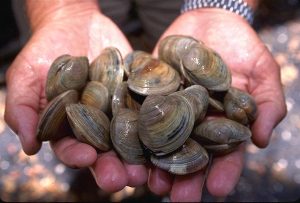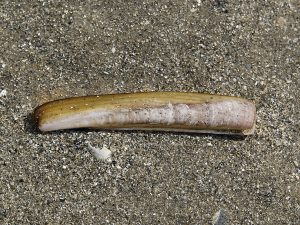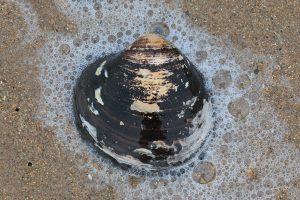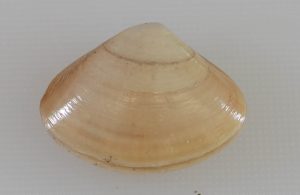Maine Seafood Guide – Hard Clams

Season
Status
Regulatory Authority
Harvest Method
Recreational Harvest
Health Benefits & Risks
Buying & Preparing
Brands
Certifications
Links
►Species Description
Hard clams (see also soft-shell clams)
Ocean quahog or mahogany clam Arctica islandica
Atlantic surf clam or hen clam Spisula solidissima
Cherrystone, littleneck, or quahog Mercenaria mercenaria
Razor clam Ensis directus
Wild. Aquaculture of hard clams in Maine is limited to two farms growing Mercenaria, and remains a focus of research efforts.
Mahogany clam is the name for small ocean quahogs harvested from Maine’s coastal waters. Ocean quahog are found from Iceland to North Carolina from nearshore to deep waters in mostly sand bottom. Ocean quahogs are among the longest-lived marine organisms in the world, capable of living longer than 200 years.
The large surf or hen clam (up to ten inches) burrows in sand on the continental shelf and beneath the turbulent waves of the breaker zone from Gulf of St. Lawrence to North Carolina.
Hard clams or quahogs (also referred to as cherrystones and littlenecks, depending on their age/size), are found from the Gulf of St. Lawrence to Florida in sand and mud habitats from the intertidal zone to sheltered subtidal hard mud and sand.
Razor or jackknife clams burrow deep in sandy mud of the low intertidal and subtidal zone.
View a gallery of different hard clam species.
►Season
Year-round.
►Status
Ocean quahog (mahogany clam) population levels remain relatively high and fishing mortality rates are relatively low. The stock is not overfished and overfishing is not occurring.
Atlantic surf clam populations are healthy and are harvested at a sustainable rate.
Hard clam (Mercenaria) status is unknown. There is a small but productive wild hard clam fishery on the New Meadows River in West Bath.
Razor clam status is unknown; there is no commercial-scale fishery.
►Regulatory Authority
Maine Department of Marine Resources; in federal waters (three to 200 miles from shore), ocean quahog and surf clam are managed by the Mid-Atlantic Fishery Management Council.
►Harvest Method
Hydraulic or hand dredge, digging by hand with a rake. See the vessel and gear guide for more information.
►Recreational Harvest
Mahogany clams are limited to 3 bushels per person per day.
Quahogs must be thicker than 1 inch across the hinge width, one peck per person per day.
Razor clams have a 4-inch minimum, one peck per person per day.
Atlantic surf clams have no size limit, and are limited to 3 bushels per person per day.
Putting salt on a razor clam hole will often make it rise up out of the sediment.
![]() If collecting for personal use, obtain a recreational harvesting license from the town office, and check with the Department of Marine Resources to make sure the area is open to harvesting, 1-800-232-4733 or 207-624-7727.
If collecting for personal use, obtain a recreational harvesting license from the town office, and check with the Department of Marine Resources to make sure the area is open to harvesting, 1-800-232-4733 or 207-624-7727.
Some areas, such some state parks, allow visitors to gather clams with the price of admission, or for free if the park is not open.
►Health Benefits & Risks
All clams are low in fat and calories and are an excellent source of selenium, iron, and vitamin B12. Clams are a good source of zinc and contain omega-3 fatty acids. Clams are low in mercury.
![]() Clams are filter-feeders and thus are vulnerable to bacterial pollution, chemical contamination, and harmful algal blooms (red tide), especially spring through fall. Clams in the market and on the menu are safe, when purchased from a certified shellfish dealer. If harvesting recreationally or for personal consumption, check the DMR’s list of closed areas before digging, 1-800-232-4733 or 207-624-7727.
Clams are filter-feeders and thus are vulnerable to bacterial pollution, chemical contamination, and harmful algal blooms (red tide), especially spring through fall. Clams in the market and on the menu are safe, when purchased from a certified shellfish dealer. If harvesting recreationally or for personal consumption, check the DMR’s list of closed areas before digging, 1-800-232-4733 or 207-624-7727.
Eating raw clams comes with some risk of exposure to viruses and bacteria, especially for people with compromised immune systems.
►Buying & Preparing
Large ocean quahogs have relatively small, dark, and tough meats, and are used in processed clam products such as soup, chowder, and sauces. Smaller ocean quahogs from Maine waters marketed as “mahogany clams” are sold on the raw half-shell market or for steaming. Use as substitute for cherrystones or littlenecks.
Surf clams are used in processed clam products such as breaded clam strips, minced clams, stuffed clam products, chowders, and broth.
If a clam’s shell is ajar before cooking, squeeze it together. If the shell remains closed, the clam is fine. If the shells spring apart when the pressure is released, do not eat it. After steaming or cooking, throw away those clams that have not opened.
►Companies, Brands, and Labels
- Bar Harbor Whole Maine Cherrystone Clams (canned)
- J.P.’s Shellfish Mahogany Clams (wild)
- Maine Shellfish (wild)
►Certifications & Verifications
None.
►Links
►Featured Harvester
|
|
 |
|
 |


